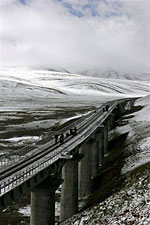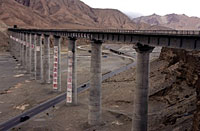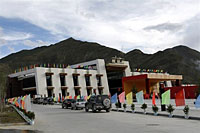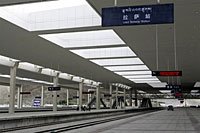




HONG KONG—China’s multi-billion-dollar railway into Tibet opens July 1, amid concerns from environmentalists and Tibetan exiles that it will bring destruction and a new influx of Han Chinese into the remote Himalayan region.
The new railway line, built at a cost of U.S.$3.76 billion, climbs 5,072 meters (16,640 feet) in altitude and traverses the snow-covered Tibetan plateau.
Its maiden trip was scheduled to start at 9 a.m. in Golmud city in northwest China’s Qinghai province, bound for Lhasa with about 600 passengers on board, the official Xinhua news agency said.
Chinese authorities have said they hope the new railway will boost economic development in China’s far West, which lags far behind the wealthier coastal areas of the eastern seaboard. Tourism is expected to increase substantially, along with the export of Tibet’s mineral resources.
Critics say the projected influx of tourists and traders will irreversibly erode the region’s unique Buddhist culture, wreak havoc on the environment, and displace Tibetans from their own native land.
Since travel to Tibet by train will be much cheaper, many Tibetans are greatly worried about the influx of all kinds of Chinese, including thieves and other criminals.
The Tibetan Youth Congress has called construction of the railway “demographic aggression,” saying Beijing planned to use it to relocate 20 million Chinese in Tibet in the next decade—displacing ethnic Tibetans native to the region.
“Since travel to Tibet by train will be much cheaper, many Tibetans are greatly worried about the influx of all kinds of Chinese, including thieves and other criminals,” one Tibetan woman said in an interview with RFA's Tibetan service.
China’s official Xinhua news agency said the number of tourists to Tibet was expected to grow by 15-20 percent each year with the opening of the rail link. A total of 2.5 million tourists were expected to visit Tibet in 2010, with the number rising to 6 million in 2020, it said.
The agency also reported that the Potala Palace—a UNESCO World Heritage Site and chief residence of the Dalai Lama until he fled to India in 1959—would receive an additional 800 visitors daily once the railway opened.
The Potala Palace would “raise its daily entry quota from 1,500 to 2,300 as of July 1,” Xinhua said, adding that many more visitors would still be turned away to protect the palace.

The International Campaign for Tibet (ICT) meanwhile said in a statement that the railway was opening “in an increasingly repressive political climate.”
“Security is tight in Lhasa this week as the government steps up its patriotic education and ‘strike hard’ campaigns, and Tibet’s Party chief [Zhang Qingli] emphasizes a ‘fight to the death struggle’ against the Dalai Lama and his supporters,” ICT said.
On June 30, three activists on a private trip to China—from Britain, Canada, and the United States—scaled the façade of the Beijing railway station to hang a banner reading “China’s Railway: Designed to Destroy,” Tenzin Dorjee, spokesperson for Students for a Free Tibet, told RFA’s Tibetan service.
The three were identified as Katie Mallin, 34, from London, Omi Hodwitz, 29, from Canada, and Cathy Nikeefe, 36, from the United States.
“Almost immediately local Chinese security officials took them away,” Tenzin Dorjee said. “Now we know that they were not detained and interrogated but taken to the airport and deported… to Hong Kong. In the past, Chinese officials used to detain such protestors and interrogate them.”
After landing in Hong Kong, Nikeefe said that the group’s protest marked “our solidarity with Tibetans inside Tibet who have attempted to sound an alarm over China’s Tibet railway but were unable to make even the mildest criticism of China’s destructive policies without facing severe repercussions.”

In an apparent bid to assuage environmental fears, Xinhua addressed the issue in its news coverage of the opening and stressed Beijing’s professed aim of “bringing prosperity to the Tibetan people.”
“The cars were installed with environment-friendly toilets, wastewater deposit tanks and garbage treatment facilities with the aim of protecting the environment along the railroad,” it said.
“The railway is the first to connect the Tibet Autonomous Region with other parts of China. It is one of China’s key projects in the West, which demonstrates the Chinese government’s determination to bring prosperity to the Tibetan people and promote the economic development of the vast western areas of China,” Xinhua said.
The environmental groups WWF and TRAFFIC called for conservation measures to protect the world’s largest and highest plateau, which is home to large numbers of rare and endangered species, including the Tibetan antelope, Tibetan gazelle, wild yak, blue sheep, snow leopard, brown bear, Bengal tiger, and black-necked crane.

Almost all of Asia’s major rivers, including the Yellow River, Yangtze, Mekong and Indus, have their source there. “Because of its high elevation, the ecosystem here is extremely fragile,” said Dawa Tsering, head of the WWF China Program Office in Lhasa.
“Once damaged, it is extremely difficult to reverse. Integrating the needs of local development with conserving Tibet’s biodiversity is in need of urgent attention.”
“The sale of souvenirs and other products made from endangered species is growing due to tourist consumption, and is increasing pressure on local biodiversity,” Tsering added. “Tourists can make a difference simply by not purchasing these products.”
Railway Project Deputy Director Zhu Zhensheng this week said the railway would improve the lives of Tibetans and promote the region’s traditional culture.
“Tibetan culture needs to move forward and spread, and to do that it needs contact,” he told a news conference in Beijing on June 29. “I’m sure that an isolated setting doesn’t help a culture to develop,” Reuters news agency quoted him as saying.
He also said environmental issues had been taken into account.
“The ecosystem on the Qinghai-Tibet Plateau is quite fragile,” Zhu said. “The environmental protection tasks have been fulfilled.” He said the line used special pipes and materials to insulate the permafrost from damage.
Tibet has been ruled by China since People's Liberation Army troops annexed the region in 1950. The Dalai Lama, the region’s spiritual leader, fled to India in 1959 after a Tibetan uprising failed. He then established a government-in-exile in Dharamsala, northern India.
Original reporting from RFA's Tibetan service. Director: Jigme Ngapo. Translated and edited by Karma Dorjee. Written for the Web in English by Sarah Jackson-Han and edited by Luisetta Mudie.